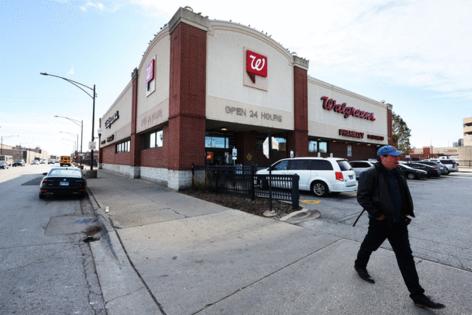Editorial: Walgreens' woes are about more than an iconic Chicago company's future. Our health is at stake, too
Published in Op Eds
Walgreens Boots Alliance has a storied history in Chicago, starting with a single retail outlet in 1901, and expanding across the globe since then.
Today, it’s shrinking fast.
The venerable drugstore chain has said one-fourth of its 8,000-plus U.S. stores are unprofitable. Last month it announced plans to shutter 1,200 of the underperformers, and hundreds more could be on the chopping block soon if they don’t pick up business from the ones that close. In its most recent quarter, Walgreens was losing money at the rate of a billion dollars per month.
Arch-competitor CVS also is feeling financial pressure and shutting stores, and Rite Aid emerged from bankruptcy in September after shedding hundreds of its outlets. The result is a looming crisis as “pharmacy deserts” expand, especially in Black and Latino neighborhoods that already are underserved by national retailers of all stripes.
The Big Three drugstore chains are suffering from many ills, including staff burnout and an uptick in shoplifting. Competition has intensified from Amazon, Walmart, supermarkets and dollar stores. The U.S. consumer is still smarting from the high cost of living brought on by inflation. A temporary sales boost from COVID-19 tests and vaccinations has ended.
Misguided mergers and acquisitions have hurt: Walgreens bought almost 2,000 Rite Aid locations, including some no doubt destined to close, and recently announced plans to unload the VillageMD primary-care provider it acquired a few years ago. None of the chains have succeeded in a big way online, especially compared WITH e-commerce juggernaut Amazon.
The retail drugstore model is broken, threatening an important fixture of the U.S. health care system that millions of Americans rely on.
At Walgreens, a new management team is trying to reinvent the drugstore, but to hear them tell it, there’s a boogeyman standing in their way. Pharmacy benefit managers have become the scapegoat for everything wrong with the prescription drug business, including underperforming retail pharmacy chains.
PBMs, as they’re known, are a juicy target. These companies act as middlemen between drugmakers and patients. They create preferred medication lists for health plans, negotiate rebates with Big Pharma and reimburse pharmacies for filling prescriptions.
PBMs search for every way to cut costs for the health insurers and others they work for. That can result in higher prices for consumers, limited access to sought-after drugs, a thicket of red tape and occasional scandals when PBMs pocket rebates intended for patients.
One PBM, Centene Corp., agreed to pay the state of Illinois $57 million a few years back to settle an investigation into alleged overbilling of Medicaid programs. More recently, Caremark, a PBM owned by CVS, agreed to pay the state $45 million amid allegations it failed to pass along rebates. Those amounts are a pittance compared with the power of PBMs to manipulate the drug market, according to their critics.
Addressing Wall Street analysts last month, Walgreens’ executives complained repeatedly about PBMs squeezing them with stingy reimbursements. In the conference call, Chief Executive Officer Tim Wentworth said that all he wants is to pay a “fair” price for drugs and get “paid fairly for the value that we provide.”
That sounded a bit naive coming from the former CEO of a giant PBM, Express Scripts. Wentworth went on to reveal that some PBMs are playing ball by, for instance, rebalancing reimbursement rates for branded drugs versus generics, which were skewed to make money for PBMs.
But Wentworth also talked tough: Walgreens will cut ties with PBMs that don’t provide “reasonable reimbursement,” he said. “We’re willing to walk away from a line of business if it doesn’t make sense.”
This is where politicians get alarmed, at the prospect of not only neighborhood stores closing, but some patients being shut out of others. The outlook for political action, though, is muddy. At the federal and state levels, bipartisan efforts to restrict PBM business practices have mostly stalled, and a Federal Trade Commission probe has an iffy future after ex-President Donald Trump’s election victory on Nov. 5.
For their part, PBMs say they are among the only effective checks on drugmakers’ pricing power, and some evidence backs them up. Casey Mulligan, a University of Chicago economist, concluded in a research study last year that legislation limiting how PBMs get paid could shift billions of dollars annually from patients and taxpayers into the pockets of drugmakers and retail pharmacy companies.
Given the immense fortune being divided by profit-seeking entities in the prescription drug game, it’s no wonder money-losing Walgreens feels shortchanged.
Walgreens is in a world of hurt, as we’ve written before, due to self-inflicted wounds, including a store experience that in too many cases for consumers is badly wanting. Wentworth says his team is working on improving the stores. They indeed have much to do along those lines.
But that’s not to say that Wentworth is wrong to call attention to a pharmaceutical market gone awry. In his quarterly call with analysts last month, Wentworth said Walgreens had struck new deals with 80% of its PBMs, but that leaves 20% — still a substantial chunk — to be addressed.
Trump and his administration-in-formation have many issues on their plate, but a broken retail pharmaceutical model can’t be ignored. Pharmacy deserts can strike ruby-red rural areas in just the same way they afflict low-income urban neighborhoods.
What’s at stake in these intramural health-industry battles is nothing less than the health of ordinary Americans.
_____
©2024 Chicago Tribune. Visit chicagotribune.com. Distributed by Tribune Content Agency, LLC.




























































Comments